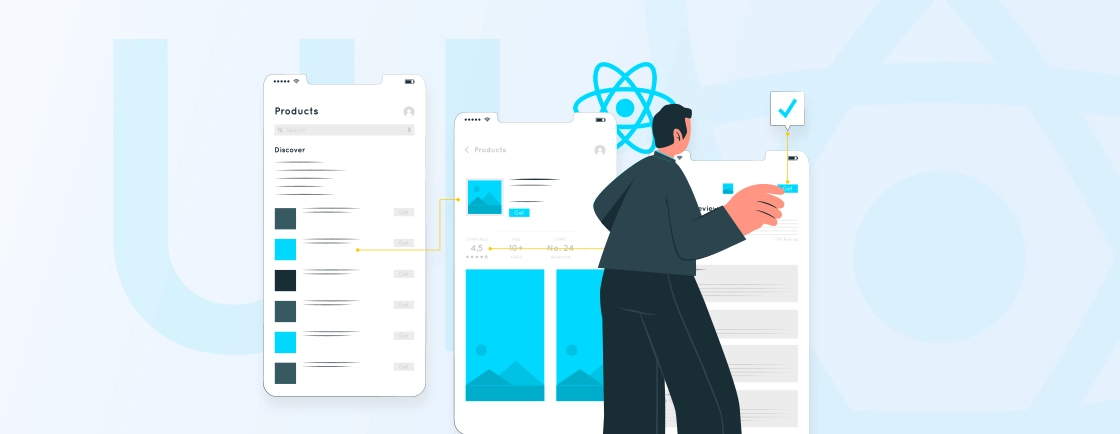Table of Contents
When it comes to a mobile app, two of the biggest traits necessary are performance and user experience. And if you are building something like a real-time chat app, eStore app, or another data-driven app, choosing the right database is imperative. It will have a direct impact on the speed, security, and data synchronization.
When it comes to the best React Native databases, there are several options available. Like Firebase, Realm, SQLite, WatermelonDB, and more. But how do you decide which one fits your project’s needs?
Don’t worry; through this blog, I’ll list down the top databases for React Native mobile applications. And I’ll explain how the React Native experts choose the right one for a project. So let’s begin.
What is a React Native Database?
A React Native database is a structured storage system that allows mobile apps to store, retrieve, and manage data efficiently. Unlike traditional web databases, React Native databases must handle unique mobile challenges. These can be offline functionality, real-time sync, and device storage limitations.
These databases can be server-based for cloud-backed apps or local for offline-first experiences. Some prioritize speed, while others focus on scalability or seamless synchronization. Choosing the right one depends on your app’s requirements.
Top React Native Databases
Whether you need real-time sync, offline support, or complex querying, it’s important to select the right React Native database. Here are the top ones.
Local Databases for React Native
React Native local databases store data directly on devices, enabling offline access and fast performance. Ideal for apps needing persistent storage without constant network connectivity.
1. Firebase

Firebase offers two powerful NoSQL databases for React Native—Realtime Database for simple, low-latency sync and Firestore for scalable, structured data. Both integrate seamlessly with authentication and cloud functions. That makes them ideal for apps needing live updates (like chat or gaming).
While Realtime Database is lightweight, Firestore supports complex queries and offline persistence. However, Firebase’s pricing can scale unpredictably with heavy usage, so monitor your reads/writes carefully.
Key Features of Firebase
- Real-time Sync: Instant updates across devices
- NoSQL Structure: Flexible JSON-based data
- Offline Support: Caches data for offline use
- Built-in Auth & Cloud Functions: Easy backend integration
- Scalability: Handles large user bases (but watch costs)
2. SQLite

A battle-tested relational database, SQLite is embedded directly into apps, offering ACID compliance without a server. It’s perfect for apps needing structured data (e.g., finance trackers) but requires manual SQL queries or wrappers like react-native-sqlite-storage.
While it lacks built-in sync, libraries like TypeORM can help. Its main downside? Complex queries can slow down performance compared to NoSQL options.
Key Features of SQLite
- ACID-compliant: Ensures data integrity
- Relational Model: Supports complex queries with SQL
- Serverless: No backend required
- Lightweight: Minimal app size impact
- Battle-tested: Used in production for decades
3. Watermelon DB

Built for React Native, WatermelonDB combines SQLite’s power with an optimized sync engine. It lazy-loads data, ensuring smooth performance even with large datasets (e.g., note-taking apps).
Unlike Realm, it uses SQLite under the hood, making migrations easier. Its sync system works with any backend, but setup requires more effort than Firebase. Ideal for apps needing offline-first with eventual cloud sync.
Key Features of Watermelon DB
- Optimized for React Native: Smooth performance with large datasets
- SQLite Backend: Reliable & familiar storage
- Lazy Loading: Only loads data when needed
- Sync-ready: Works with custom backends
- Observable Queries: Auto-updates UI on data changes
4. Couchbase Lite

A NoSQL JSON-based database with built-in sync via Couchbase Server. It excels in edge computing (e.g., field service apps) with conflict resolution and peer-to-peer sync. Unlike Firebase, it’s self-hostable, avoiding vendor lock-in.
However, its complex setup and larger binary size may deter smaller projects. Best for enterprises needing flexible, decentralized data.
Key Features
- NoSQL (JSON-based): Flexible schema design
- Multi-platform Sync: Peer-to-peer & cloud sync
- Conflict Resolution: Handles offline edits gracefully
- Self-hostable: Avoid vendor lock-in
- Enterprise-ready: Secure & scalable
5. PouchDB

PouchDB stores data locally in JSON format and syncs seamlessly with CouchDB or cloudant. Its API mirrors Firebase but is open-source and self-hostable. Great for progressive web apps (PWAs) or hybrid mobile apps, though performance lags in very large datasets. Sync is reliable but slower than Firebase’s WebSockets.
Key Features of PouchDB
- API-compatible With CouchDB: Easy cloud sync
- Open-source & Self-hostable: No vendor restrictions
- Offline-first: Works without internet
- Lightweight: Good for PWAs & simple apps
- Eventual Consistency: Syncs when online
6. Vasern

A minimalistic, performance-focused database designed for React Native. Vasern uses a custom storage engine (not SQLite) for speed, making it ideal for simple key-value or document storage (e.g., to-do apps). However, its young ecosystem means fewer community resources and no built-in sync. Best for lightweight apps prioritizing raw speed over features.
Key Features of Vasern
- Ultra-fast: Custom storage engine (not SQLite)
- Simple API: Easy key-value & document storage
- Lightweight: Minimal dependencies
- React Native Optimized: Built for mobile performance
- No Sync By Default: Best for offline-only apps
Server-side Databases for React Native
Server-side databases store data in the cloud, offering centralized management and real-time sync. Best for apps requiring scalability, collaboration, or complex queries.
7. MongoDB

MongoDB’s flexible document model pairs perfectly with React Native through MongoDB Realm or Atlas Device Sync. Its JSON-like structure simplifies data handling, while built-in sync enables real-time updates across devices.
Ideal for apps needing schema flexibility and horizontal scalability. Requires careful indexing for optimal performance in large datasets.
Key Features of MongoDB
- Document-Oriented: Flexible JSON-like (BSON) data structure
- Atlas Device Sync: Real-time data synchronization for mobile
- Scalability: Horizontal scaling with sharding
- Rich Querying: Powerful indexing & aggregation framework
- Multi-cloud Support: Works across AWS, Azure & Google Cloud
8. PostgreSQL

PostgreSQL is a powerful, open-source relational database that works well with React Native through client libraries like react-native-postgresql or via REST/GraphQL APIs. Its structured schema and ACID compliance ensure reliable, consistent data handling, while support for advanced queries and relationships allows complex data models.
Ideal for apps that require strong data integrity, complex queries, and transactional consistency. This approach is best suited for structured datasets where relationships between tables are important.
Key Features of PostgreSQL
- ACID-Compliant: Full transactional reliability
- Relational + JSON Support: Structured tables with JSONB flexibility
- Advanced SQL Features: Window functions, stored procedures
- Geospatial Ready: PostGIS extension for location data
- Highly Extensible: Custom data types & functions
9. MySQL

MySQL, the world’s most popular open-source RDBMS works with React Native through API layers. Known for reliability and speed in structured data scenarios. Limited JSON support compared to PostgreSQL.
Best for apps requiring traditional relational models with proven stability. Connection pooling is essential for mobile performance.
Key Features of MySQL
- Proven RDBMS: Most widely used open-source database
- High Performance: Optimized for read-heavy workloads
- Replication Support: Master-slave & group replication
- Cross-platform: Runs on all major operating systems
- Strong Community: Extensive documentation & support
10. AWS DynamoDB

Amazon’s serverless NoSQL database delivers single-digit millisecond latency at any scale. Integrated with AWS Amplify for seamless React Native connectivity. Pay-per-use pricing and automatic scaling make it cost-effective.
Best for apps with unpredictable workloads. Steep learning curve for partition key optimization.
Key Features of AWS DynamoDB
- Serverless Architecture: No infrastructure management
- Single-digit ms Latency: Consistent performance at any scale
- Auto-Scaling: Handles unpredictable workloads seamlessly
- Built-in Security: IAM integration & encryption at rest
- Global Tables: Multi-region replication out-of-the-box
Each of these React Native databases has its own strengths and weaknesses. You need to choose the best option based on your app’s data complexity, scalability needs, and team expertise.
Or you may consult with our professional React Native development company. We analyze the app requirements, explore the top options and select the best accordingly.
How to Choose the Best React Native Database?
Choosing the database is one of the key parts of building a React Native app. So you need to consider a few key factors and make the decision accordingly.
Complexity of Data
The structure of your data determines whether you need a relational (SQL) or document-based (NoSQL) database. For apps with complex relationships (e.g., financial tracking), SQLite or PostgreSQL offers strict schema enforcement and JOIN operations.
NoSQL options like Firebase or MongoDB better suit hierarchical or unstructured data (e.g., user profiles). Consider query patterns—if you need advanced aggregations, a relational database may save development time despite steeper setup.
Syncing Data Offline
Offline capability is critical for mobile apps in low-connectivity scenarios. Databases like Realm and WatermelonDB prioritize local-first strategies with seamless sync when back online. Firebase handles this automatically but lacks control over conflict resolution.
For peer-to-peer sync, Couchbase Lite excels. Evaluate sync granularity—full-database sync (PouchDB) vs. field-level (Realm)—to balance performance and data freshness.
Ease of Use
Developer experience impacts productivity. Firebase and Supabase offer SDKs with built-in auth and APIs, reducing backend code. SQLite requires manual query writing but has extensive tutorials.
Weigh setup complexity against long-term maintainability—Realm’s object-oriented approach simplifies code but locks you into its ecosystem. Opt for databases with active communities (like MongoDB) for faster troubleshooting.
Memory Handling
Large datasets can cripple app performance. WatermelonDB lazy-loads data to minimize memory usage, while SQLite efficiently paginates queries. NoSQL options like Firebase cache aggressively but may bloat memory.
Benchmark read/write operations during prototyping. Databases with binary storage (Realm) often outperform JSON-based ones (PouchDB) in memory-intensive apps like media editors.
Managing Data Conflicts
Conflict resolution is vital for collaborative apps. Couchbase Lite and Firebase use timestamp-based “last write wins,” while Realm allows custom merge logic. For financial apps, ACID-compliant databases (SQLite) prevent overlaps via transactions.
Assess conflict frequency—real-time apps (multiplayer games) need robust strategies compared to solo productivity tools.
Concurrency
High user loads demand databases that handle parallel operations. PostgreSQL supports row-level locking, ideal for multi-editor apps. Serverless options like DynamoDB scale automatically but suffer from eventual consistency.
Local databases (SQLite) use file locking, which can bottleneck writes. Test under load—opt for databases with optimistic concurrency control (Realm) for smoother multi-user experiences.
If you still need help with the selection and setup of React Native databases, better consult with the professionals.
Let’s Summarize
Choosing the right database for your React Native app impacts performance, scalability, and user experience. Do you prioritize real-time sync, offline functionality, or complex querying? Then there’s a database tailored to your needs—from Firebase for seamless cloud integration to SQLite for reliable local storage.
Consider your app’s specific requirements: data structure, synchronization needs, and future growth. Test different options early to avoid costly migrations later.
If you still need help setting up the database for your app, hire React Native developer to ensure seamless integration and optimized performance from the start.
FAQs on React Native Databases
Can React Native work with SQL databases?
Yes! SQLite is a popular embedded SQL database for React Native, ideal for structured data. For server-side SQL, PostgreSQL or MySQL can be accessed via APIs or ORMs like TypeORM.
How do I handle offline data sync in React Native?
Databases like WatermelonDB, Firebase, and Couchbase Lite support offline-first development with automatic sync when connectivity resumes. Conflict resolution strategies vary—some use “last write wins,” while others allow custom merging.
Can I use multiple databases in a single React Native app?
Yes—for example, SQLite for local storage and Firebase for real-time sync. However, managing multiple databases increases complexity, so consolidate where possible.
What’s the best way to test database performance in React Native?
Benchmark read/write operations under simulated load (e.g., Jest for unit tests, Detox for end-to-end testing). Monitor memory usage in Xcode/Android Studio and test offline scenarios to evaluate sync behavior.
Build Cross-Platform React Native Apps
Discover how to create cross-platform mobile applications using React Native.





